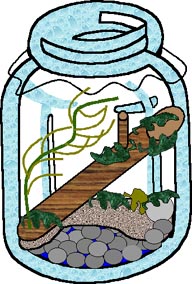 | ||||||
| Articles | Projects | Resume | Cartoons | Windsurfing | Paintings | Album |
Welcome to the Waterose Environmental Science Eco Jar Project


Build an Eco Jar
Hold the World in Your Hands
A totally closed loop ecosystem that recycles air, oxygen, carbon dioxide, water, nutrients, and micro-organisms;
Great teaching tool for environmental stewardship!

Here's what you need and how you do it!
- Obtain a used large glass or plastic jar.
- Add one layer of stone pebbles.
- Then add two or three larger rocks with moss growing on them.
- Add a thin layer of sand from a beach, then a thin layer of soil from the forest, which contains bacteria, and spread it around the larger rocks, on top of the pebbles.
- Add small patches of different kinds of moss, and nestle these on top of the soil.
- Try and find a small rotting branch or log, that has a small fern growing out of it. This is your oxygen maker. Or if not a fern, then one or two small herb plants.
- Add real stream water, just enough to make all the pebbles on the bottom layer wet. This is your bacteria.
- Then cover the top of the jar with a layer of air tight saran wrap. This prevents air and moisture escaping from the jar.
- Finally, secure a rubber band around the film wrap at the neck of the jar, to keep the film wrap securely in place.
- That's it! You're done! Place this jar in a window.
- The energy from the sun will drive the ecosystem in the jar, just like it drives the ecosystems on the earth. This mini ecosystem is totally maintenance free.
- The water will recycle by evaporating to the top of the jar, condensing, and falling down, just like rain.
- The oxygen and carbon dioxide cycle is balanced by the small plants inside the jar.
- The nutrients will recycle by the plants growing, dying, and being decomposed by the micro-organisms in the soil and water.
- Try adding different kinds of plants growing on different kinds of substrates. Different mosses on rocks, branches, twigs, and bark. Or even, try lichen that sources it's nutrients from the air!
I use these ecojars to help demonstrate linkages when discussing the importance of recycling for the environment, the impacts of burning solid waste and how smaller molecules travel in the environment via the grasshopper effect, the impacts of pouring chemicals into our environment and how they end up in our streams, river, lakes, oceans and food chain, the importance of recycling nutrients in the biological compartment, and the linkage between solid waste and liquid waste. They are great draws at public displays and make a great classroom project. I have a large one in a ten gallon aquarium that has been going unopened since August 1997, a medium one in a large glass jar that has been going unopened since Spring 2000 and I am trying out a new mini eco jar that has been going since November 2000. They also look great in old gold fish bowls. Try making one as a gift for a friend - they'll love it!
This presentation is also available on Video from Shaw Cable TV in Victoria, British Columbia in Canada.
So, try it! Recycle for the environment and for future generations.
Eco-jar Photo by Bryan Dreilich for the Sooke News Mirror April 25, 2001

Sooke elementary school was participating heavily in Earth Week during April 2001, as Grade 5 student John Wilson demonstrated how to build an Eco-jar, which is a small, closed ecosystem in a jar, in Bryan Johnsonís class.


 email Waterose
email Waterose
Please Sign My Guestbook
Please View My Guestbook

| Articles | Projects | Resume | Cartoons | Windsurfing | Paintings | Album |
 | ||||||